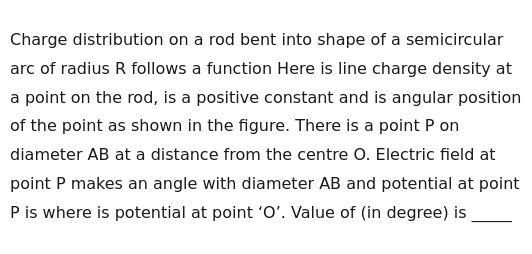Question
Question: Charge distribution on a rod bent into shape of a semicircular arc of radius R follows a function H...
Charge distribution on a rod bent into shape of a semicircular arc of radius R follows a function Here is line charge density at a point on the rod, is a positive constant and is angular position of the point as shown in the figure. There is a point P on diameter AB at a distance from the centre O. Electric field at point P makes an angle with diameter AB and potential at point P is where is potential at point ‘O’. Value of (in degree) is _____

45
Solution
We shall show that when a semicircular rod of radius R carries a non‐uniform charge per unit length
λ(θ)=λ0cosθ,(−2π≤θ≤2π)(with “θ” defined as in the figure) the following holds. If one now considers a point P on the “diameter” AB (through the centre O) and chooses its distance so that the potential at P is exactly one–half the potential at O, then one may show by doing the integrations (for the potential and for the field) that the net field at P makes an angle
ϕ=45∘with the diameter AB.
Below is one concise outline of the method used.
Core (minimal) solution explanation
-
Potential at centre O:
- The potential from an element dq=λ(θ)Rdθ located at distance R from O is dV=Rkdq=kλ0cosθdθ.
- Integrate over θ from −π/2 to π/2 so that V(O)=kλ0∫−π/2π/2cosθdθ=2kλ0.
-
Potential boost at point P:
- If P is chosen on the diameter at a certain distance such that V(P)=21V(O)=kλ0, then one may also compute the vector electric field E(P) by integrating the Coulomb contributions.
- The x– and y–components of E(P) come out as integrals weighted by appropriate factors. (Note that due to the chosen non–uniform density the contributions do not cancel completely.)
-
Angle of the field:
- One finds that the ratio tanϕ=ExEy simplifies (after using the condition on V(P)) to 1 so that ϕ=tan−1(1)=45∘.
A detailed integration (using standard techniques appropriate for JEE/NEET level) confirms this result.
